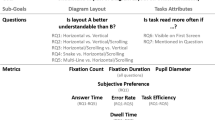Abstract
Due to the use of thousands of often very complex process models, having them immediately usable towards their purpose is of great economic benefit. In order to maximize usability, process models must be intuitive and easily understandable. In other words, processing the information contained within the process models must enable a successful completion of the task for which the model is being used. Recently, research efforts into the effects of user characteristics on understandability have increased. However, current limitations create promising research possibilities, particularly with regard to the use of realistic process models and direct data collection techniques. This thesis will contribute to the existing body of knowledge by investigating domain knowledge as a fundamental user characteristic and utilizing eye-tracking as a direct data collection method while using realistic, complex process models. The end goal of this research is to propose an automatic process model tailoring technique, with the aim of enhancing a user’s understanding and thus their performance. As of now a pilot study has indicated the existence of distinct reading strategies, which establishes the viability of the proposed future work.
Access this chapter
Tax calculation will be finalised at checkout
Purchases are for personal use only
Similar content being viewed by others
References
Figl, K.: Comprehension of procedural visual business process models. Bus. Inf. Syst. Eng. 59, 41–67 (2017). https://doi.org/10.1007/s12599-016-0460-2
de Oca, I.M.M., Snoeck, M., Reijers, H.A., Rodríguez-Morffi, A.: A systematic literature review of studies on business process modeling quality. Inf. Softw. Technol. 58, 187–205 (2015). https://doi.org/10.1016/j.infsof.2014.07.011
Dehnert, J., Van Der Aalst, W.M.P.: Bridging the gap between business models and workflow specifications. Int. J. Coop. Inf. Syst. 13, 289–332 (2004)
Mendling, J., Strembeck, M., Recker, J.: Factors of process model comprehension-Findings from a series of experiments. Decis. Support Syst. 53, 195–206 (2012). https://doi.org/10.1016/j.dss.2011.12.013
Turetken, O., Rompen, T., Vanderfeesten, I., Dikici, A., van Moll, J.: The effect of modularity representation and presentation medium on the understandability of business process models in BPMN. In: La Rosa, M., Loos, P., Pastor, O. (eds.) BPM 2016. LNCS, vol. 9850, pp. 289–307. Springer, Cham (2016). https://doi.org/10.1007/978-3-319-45348-4_17
Heinrich, L.J., Riedl, R., Stelzer, D., Sikora, H.: Informationsmanagement: Grundlagen, Aufgaben, Methoden. De Gruyter, München (2014)
Reijers, H.A., Mendling, J.: A study into the factors that influence the understandability of business process models. IEEE Trans. Syst. Man Cybern. 41, 449–462 (2011). https://doi.org/10.1109/TSMCA.2010.2087017
Petrusel, R., Mendling, J.: Eye-tracking the factors of process model comprehension tasks. In: Salinesi, C., Norrie, M.C., Pastor, Ó. (eds.) CAiSE 2013. LNCS, vol. 7908, pp. 224–239. Springer, Heidelberg (2013). https://doi.org/10.1007/978-3-642-38709-8_15
Aysolmaz, B., Reijers, H.A.: Towards an integrated framework for invigorating process models: a research agenda. In: Reichert, M., Reijers, H.A. (eds.) BPM 2015. LNBIP, vol. 256, pp. 552–558. Springer, Cham (2016). https://doi.org/10.1007/978-3-319-42887-1_44
Kolb, J.: Abstraction, Visualization, and Evolution of Process Models. Ulm University (2015)
Figl, K., Strembeck, M.: On the importance of flow direction in business process models. In: Proceedings of the 9th International Conference on Software Engineering and Applications (ICSOFT-EA 2014), pp. 132–136 (2014)
Haisjackl, C., Soffer, P., Lim, S.Y., Weber, B.: How do humans inspect BPMN models: an exploratory study. Softw. Syst. Model 1–19 (2016). https://doi.org/10.1007/s10270-016-0563-8
Bera, P.: Does cognitive overload matter in understanding BPMN models? J. Comput. Inf. Syst. 52, 59–69 (2012)
Recker, J., Dreiling, A.: Does it matter which process modelling language we teach or use? An experimental study on understanding process modelling languages without formal education, pp. 356–366 (2007)
Recker, J., Reijers, H.A., van de Wouw, S.G.: Process model comprehension: the effects of cognitive abilities, learning style, and strategy. Commun. Assoc. Inf. Syst. 34, 199–222 (2014)
Borgatti, S.P., Carboni, I.: On measuring individual knowledge in organizations. Organ Res. Methods 10, 449–462 (2007)
Hambrick, D.Z., Engle, R.W.: Effects of domain knowledge, working memory capacity, and age on cognitive performance: An investigation of the knowledge-is-power hypothesis. Cogn. Psychol. 44, 339–387 (2002)
Santos, E., Pimentel, J., Castro, J., Finkelstein, A.: On the dynamic configuration of business process models. In: Bider, I., Halpin, T., Krogstie, J., Nurcan, S., Proper, E., Schmidt, R., Soffer, P., Wrycza, S. (eds.) BPMDS/EMMSAD -2012. LNBIP, vol. 113, pp. 331–346. Springer, Heidelberg (2012). https://doi.org/10.1007/978-3-642-31072-0_23
Libby, R., Luft, J.: Determinants of judgment performance in accounting settings: Ability, knowledge, motivation, and environment. Acc. Organ. Soc. 18, 425–450 (1993)
Schmidt, F.L., Hunter, J.E.: Tacit knowledge, practical intelligence, general mental ability, and job knowledge. Curr. Dir. Psychol. Sci. 2, 8–9 (1993)
Patig, S.: A practical guide to testing the understandability of notations. In: Proceedings of the Fifth Asia-Pacific Conference on Conceptual Modelling, vol. 79, pp. 49–58. Australian Computer Society, Inc. (2008)
Weber, B., Pinggera, J., Neurauter, M., et al.: Fixation patterns during process model creation: Initial steps toward neuro-adaptive process modeling environments. In: 49th Hawaii International Conference on System Sciences, pp. 600–609 (2016)
Petrusel, R., Mendling, J., Reijers, H.A.: How visual cognition influences process model comprehension. Decis. Support Syst. 96, 1–16 (2017). https://doi.org/10.1016/j.dss.2017.01.005
Haider, H., Frensch, P.A.: Eye movement during skill acquisition: More evidence for the information-reduction hypothesis. J. Exp. Psychol. Learn. Mem. Cogn. 25, 172 (1999)
Nordbotten, J.C., Crosby, M.E.: The effect of graphic style on data model interpretation. Inf. Syst. J. 9, 139–155 (1999). https://doi.org/10.1046/j.1365-2575.1999.00052.x
Acknowledgements
This Ph.D. project will be funded by Ghent University (Belgium) under the supervision of Prof. Dr. Manu De Backer (administrative promoter) and Prof. Dr. Amy Van Looy (daily supervisor).
Author information
Authors and Affiliations
Corresponding author
Editor information
Editors and Affiliations
Rights and permissions
Copyright information
© 2018 Springer International Publishing AG
About this paper
Cite this paper
Vermeulen, S. (2018). Real-Time Business Process Model Tailoring: The Effect of Domain Knowledge on Reading Strategy. In: Debruyne, C., et al. On the Move to Meaningful Internet Systems. OTM 2017 Workshops. OTM 2017. Lecture Notes in Computer Science, vol 10697. Springer, Cham. https://doi.org/10.1007/978-3-319-73805-5_30
Download citation
DOI: https://doi.org/10.1007/978-3-319-73805-5_30
Publisher Name: Springer, Cham
Print ISBN: 978-3-319-73804-8
Online ISBN: 978-3-319-73805-5
eBook Packages: Computer ScienceComputer Science (R0)




